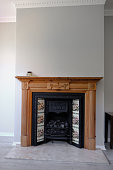
The traditional fireplace, a symbol of warmth and comfort, has remained largely unchanged for centuries. While gas and electric alternatives have emerged, the fundamental principles of wood-burning fireplaces – a firebox, a chimney, and basic ventilation – have persisted. However, recent advancements in materials science, sensor technology, and the Internet of Things (IoT) are paving the way for "Smart Fireplace Systems" that offer significant improvements in efficiency, safety, and user experience. If you treasured this article and you would like to be given more info pertaining to fireplace flue construction generously visit our own page. This article will detail these advancements, demonstrating how they represent a demonstrable leap forward in fireplace construction and operation.
1. Advanced Materials for Enhanced Heat Retention and Reduced Emissions:
The core of a traditional fireplace is its firebox. Historically constructed from brick or concrete, these materials offer basic heat resistance but are inefficient at radiating heat into the room. Furthermore, incomplete combustion within the firebox leads to significant particulate matter emissions.
Smart Fireplace Systems are incorporating advanced materials like:
High-Density Refractory Ceramics: These materials, such as silicon carbide and alumina-silica composites, offer significantly higher thermal conductivity and heat retention compared to traditional firebricks. This allows for faster heat-up times, more even heat distribution, and prolonged heat radiation even after the fire has died down. Furthermore, their higher operating temperatures promote more complete combustion, reducing smoke and creosote buildup.
Insulating Firebricks with Nanoparticle Additives: While refractory ceramics excel at heat retention, they can also lose heat through the exterior walls of the firebox. New insulating firebricks incorporate nanoparticles of materials like aerogel or carbon nanotubes to dramatically reduce thermal conductivity. This minimizes heat loss, further increasing efficiency and reducing the risk of overheating surrounding structures.
Catalytic Combustors with Precious Metal Coatings: To address emissions, Smart Fireplace Systems are integrating catalytic combustors made from ceramic honeycombs coated with precious metals like platinum or palladium. These combustors are positioned within the flue and catalyze the oxidation of unburned hydrocarbons and carbon monoxide at lower temperatures, significantly reducing smoke and harmful emissions. This technology is already employed in some high-efficiency wood stoves, but its integration into fireplace designs is a growing trend.
2. IoT Integration for Automated Control and Monitoring:
The advent of IoT technology allows for unprecedented control and monitoring of fireplace operation, leading to improved safety and efficiency. Key components of an IoT-enabled Smart Fireplace System include:
Smart Dampers: Traditional dampers are manually operated and often inefficient, leading to significant heat loss when the fireplace is not in use. Smart dampers are electronically controlled and can automatically close when the fire is extinguished or when the fireplace is not in use, preventing drafts and heat loss. They can also be programmed to partially open based on chimney temperature and pressure to optimize airflow and prevent backdrafting.
Temperature and CO Sensors: Integrated temperature sensors monitor the firebox and flue temperatures, providing real-time feedback to the control system. Carbon monoxide (CO) sensors continuously monitor CO levels in the room, triggering an alarm and automatically closing the damper if dangerous levels are detected. This significantly enhances safety and prevents CO poisoning.
Airflow Control Systems: Smart Fireplace Systems incorporate variable-speed fans and electronically controlled air inlets to precisely control airflow to the fire. This allows for optimizing combustion efficiency, reducing smoke production, and controlling the intensity of the fire. The system can automatically adjust airflow based on fuel type, chimney conditions, and desired heat output.
Remote Monitoring and Control via Mobile App: Users can monitor fireplace status, temperature, CO levels, and damper position through a mobile app. They can also remotely control the damper, airflow, and even ignite the fire using an automated ignition system. This provides unparalleled convenience and control over the fireplace.
3. Advanced Firebox Designs for Optimized Combustion:
Traditional fireplace fireboxes are often inefficient due to poor airflow and incomplete combustion. Smart Fireplace Systems are incorporating innovative firebox designs to address these issues:
Downdraft Combustion Systems: These systems introduce air from the top of the firebox, forcing smoke and unburned gases to pass through the flames before exiting the chimney. This promotes more complete combustion, reducing smoke and emissions.
Secondary Air Injection Systems: These systems inject preheated air into the upper part of the firebox, above the primary combustion zone. This secondary air helps to burn off unburned gases and particulate matter, further reducing emissions and increasing efficiency.
Three-Sided Glass Fireboxes with Air Wash Systems: These fireboxes offer a panoramic view of the fire while also incorporating an air wash system that directs a stream of air across the glass to keep it clean and clear of soot buildup. The three-sided design maximizes radiant heat output into the room.
4. Integration with Home Automation Systems:
Smart Fireplace Systems can be seamlessly integrated with existing home automation systems, allowing for coordinated control and enhanced energy efficiency. For example:
Thermostat Integration: The fireplace can be integrated with the home's thermostat to automatically adjust the central heating system when the fireplace is in use. This prevents the central heating system from overworking and saves energy.
Smart Home Voice Control: Users can control the fireplace using voice commands through smart home assistants like Amazon Alexa or Google Assistant. This allows for hands-free operation and convenient control.
Automated Fuel Delivery Systems: Some advanced systems incorporate automated fuel delivery systems that automatically replenish the firebox with wood pellets or other fuel sources. This eliminates the need for manual refueling and ensures a continuous burn.
Demonstrable Advances:
The advances outlined above represent a significant improvement over traditional fireplace construction in several key areas:
Increased Efficiency: Advanced materials and optimized firebox designs significantly increase heat output and reduce fuel consumption.
Reduced Emissions: Catalytic combustors and improved combustion techniques dramatically reduce smoke and harmful emissions, making fireplaces more environmentally friendly.
Enhanced Safety: CO sensors, smart dampers, and remote monitoring capabilities enhance safety and prevent CO poisoning.